Van Gogh and the Avant-Garde:
The Modern Landscape
Reviewed by Hollis Clayson
Hollis Clayson
Professor Emerita of Art History
Bergen Evans Professor Emerita in the Humanities
Northwestern University
Email the author: hclayson[at]gmail.com
Citation: Hollis Clayson, exhibition review of Van Gogh and the Avant-Garde: The Modern Landscape, Nineteenth-Century Art Worldwide 22, no. 2 (Autumn 2023), https://doi.org/10.29411/ncaw.2023.22.2.16.
This work is licensed under a Creative Commons Attribution-NonCommercial 4.0 International License  unless otherwise noted.
unless otherwise noted.
Your browser will either open the file, download it to a folder, or display a dialog with options.
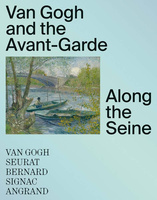
Van Gogh and the Avant-Garde: The Modern Landscape
Art Institute of Chicago
May 14–September 4, 2023
Van Gogh Along the Seine
Van Gogh Museum, Amsterdam
October 13, 2023–January 14, 2024
Catalogue:
Bregje Gerritse and Jacquelyn N. Coutré, eds.,
Van Gogh and the Avant-Garde Along the Seine.
New Haven and London: Yale University Press in association with the Art Institute of Chicago and the Van Gogh Museum, Amsterdam, 2023.
208 pp.; 200 color and b&w illus.; bibliography; notes; index.
$45.00 (hardcover)
ISBN: 978–0–300–26976–5
The title of the exhibition at the Art Institute of Chicago, Van Gogh and the Avant-Garde: The Modern Landscape, raises several questions. While it clearly states that Vincent van Gogh’s (1853–90) landscapes are displayed alongside those created by the avant-garde, it is not clear why the marquee artist is separate from “the Avant-Garde.” How are museumgoers meant to understand the separation or difference between Van Gogh and a group or a style called “the Avant-Garde”? Doesn’t he also belong? Is his work not also avant-garde in the realm of style? How precisely is the term “avant-garde” being used? Whether we conclude that the avant-garde being referenced was a radical collective or a modernist aesthetic, the title’s separation of Van Gogh from innovative contemporaries is puzzling because one of the achievements of the exhibition is the demonstration of his like-mindedness (as of 1887) with four other Paris-based innovators: Charles Angrand (1854–1926), Emile Bernard (1868–1941), Georges Seurat (1859–91), and Paul Signac (1863–1935). The question must be asked: is his name highlighted as a marketing strategy rather than a declaration of the singularity of his art? One suspects so insofar as the name, Van Gogh, habitually draws a crowd. Including the Chicago exhibition, there will have been five major Van Gogh exhibitions mounted on both sides of the Atlantic between 2022 and 2024, not anniversaries of his birth or death. Van Gogh Self-Portraits (London, The Courtauld; 2022), Van Gogh in America (Detroit Institute of Arts; 2022–23), Van Gogh’s Cypresses (New York, The Metropolitan Museum of Art; 2023), and Van Gogh in Auvers-sur-Oise: The Final Months (Paris, Musée d’Orsay; 2023–24). The number rises to six if we count the Amsterdam version of the present exhibition opening in fall 2023 with a title, Van Gogh along the Seine, that further stresses the centrality of the Dutch artist.
Acknowledging that the name “Van Gogh” is routinely used by museums to hail the attention of the maximum number of visitors is not the same thing as condemning an exhibition that uses that naming strategy. No, not at all. On the contrary, the Chicago show has much to recommend it. Before delineating the exhibition’s achievements and shortcomings, it is important to understand the singular standing of the featured artist. Van Gogh’s reputation enjoys a unique status in the sphere of modern art. His work is venerated by every segment of the art audience, from the general public to rich collectors, but also by artists and by art historians in both the academic and museum worlds.[1] That said, how should we evaluate the quality of this multi-artist exhibition? Every show of art, even one that reflexively foregrounds the art of a household name, rises or falls based upon the application of three criteria: the quality of the art on display, the clarity of the installation, and the coherence of the texts articulating the exhibition’s ideas. Vis-à-vis category one: the Chicago exhibition is chockablock with unfamiliar and altogether first-rate paintings by all five of the artists, many of which were unfamiliar to specialists including the author of this review. Regarding the installation and wall texts, the show’s accomplishment is somewhat mixed.
Dipping into the exhibition catalogue helps to clarify what point the exhibition is meant to make about the connection between the five artists. The introduction by the co-curators, Jacquelyn Coutré (of the Art Institute of Chicago) and Bregje Gerritse (of the Van Gogh Museum, Amsterdam) provides a valuable clarification.
Although they would have never conceived of themselves as a coherent group, they were unified by their pursuit of new, modern painting styles. It was through their technical experimentations and unfamiliar subject matter in and around these Parisian suburbs, as well as their exchange with each other, that these artists developed their own approaches to painting (26).
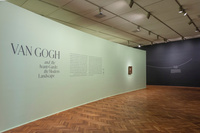
The industrializing riverain “suburbs” (banlieue would be more accurate) west and northwest of central Paris along the river Seine, increasingly full of the infrastructure of leisure and industry, is the primary locus of the work in the exhibition by all five of the artists. Asnières is the centerpiece. The way that the exhibition texts characterize the changes undergone by these towns, after the extensive mid-century modernization of the French capital (called Haussmannization after its mastermind) that pushed residents of modest income out of the city, is somewhat problematic. On the opening panel (fig. 1), the increasingly visible infrastructure of heavy industry and transport in these working-class communities (“coal cranes, factory smokestacks, and iron railroad bridges”) are called “symbols of industrialization” and “icons of this suburban landscape.” This language is elusive and serves to soften the harshness, shock, materiality, and meanings of the new industrial structures. How is the interest of the painters in working there and looking at new structures described on the opening panel? “Van Gogh was one of five avant-garde artists living in Paris who journeyed to the suburbs in search of modern subjects for their innovative techniques.” It sidesteps the avowedly difficult question of what exactly drew the artists to these sites, and what their attitudes to them and their occupants were. Was it merely a hunt for the new close-at-hand at all costs? Was it really a 100% aesthetic attraction or was something more critical, even political, going on?
Thoughts about present-day conflicts between the multi-ethnic and largely poor occupants of the Paris banlieue and the generally more bourgeois folks living in Paris inevitably come to mind while examining the artworks that fill this exhibition. When considering the attitudes of Parisians, temporary or permanent, to the occupants and the appearance of working-class communities, it is difficult not to ponder the riots in suburban Paris over the summer of 2023 following the police murder of Nahel Merzouk, a 17-year-old of North African descent, which have been compared to those surrounding the murder of George Floyd. According to the Chicago exhibition, such conflicts, clashes, and awareness of difference were not part of the ambitious later nineteenth-century artists’ remits. Nonetheless, one asks: are we not somehow obliged to ponder the sites and the relations figured in these extraordinary paintings through the lens of current troubles as well as those that took place in the same locations in 2005? Are the featured artists cosmeticizing the banlieue and its citizens? Aestheticizing difference and conflict? Lanna Hollo, a human rights lawyer in Paris, who has worked on policing issues for fifteen years, was quoted as saying, “It’s a repeating cycle, unfortunately. What characterizes France is denial. There is a total denial that there is a structural systemic problem . . . .”[2] Are the concerns voiced here anachronistic projections, or can we find a cognate recognition of difference or some kind of interpretive edge in any of the banlieue canvases? We shall see.
Among the outstanding features of the exhibition is the delineation of who knew whom at what date and in what place. Or rather we learn which artist started working in which location in the company of whom. Before this exhibition, the turn of this generation of fact-based painters to the sites bordering the capital city was well known, but the exact details of association and work schedules were not.[3] This exhibition establishes, for example, that although Seurat was the first of this group to paint in Asnières (witness his well-known Bathers at Asnières, 1884), Van Gogh began painting in Asnières in intensive, almost daily campaigns between early May and the end of July 1887. He completed forty pictures set there in that period.
One of them, Roadway with Underpass (Le viaduct), Asnières (fig. 2), was one of the more surprising canvases in the exhibition. The narrow lines of red paint used to define the edges of the road and details within the stonework are elegant in their refinement and are not used in his other paintings of this moment. And the artist’s considerable pictorial wit is manifest in two features. The chimney tops that emerge just above the foliage-covered viaduct are undeniable bits of pictorial irony. Also clever is the minimally described and transparent street light fixture that overlaps the arch. Vincent (as he came to call himself in Provence) was an avid depicter of technologized modern structures and systems in the Paris region at this time. It was an enthusiasm he continued to pursue in Arles when he arrived in early 1888, until Paul Gauguin (1848–1903) arrived later the same year.[4] Several of the canvases (fig. 3, for example) in the Chicago exhibition are very strong reminders of his distinctive attraction to the infrastructure of industry that emerged during his time in the French capital.
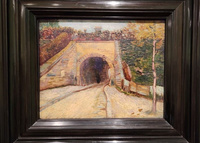
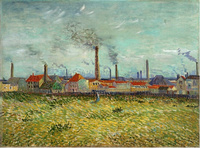
One of the eye-opening achievements of the show is the discovery of programmatic ensembles of Van Gogh landscapes made in 1887, discussed in the fine essay by co-curator Bregje Gerritse in the exhibition catalogue (66–93). He made three paintings each of Clichy, Asnières, and the island known as the Grande Jatte. The exhibition refers to these as “triptychs.” The placards in the early galleries of the show, which delineated the contents and circumstances of the triptychs, are shown below (figs. 4, 5, 6).
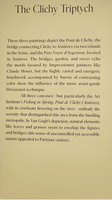
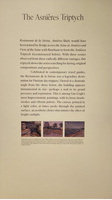
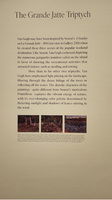
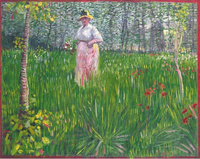
One of the canvases in the Clichy triptych, A Woman Walking in a Garden, (fig. 7), speaks to and perhaps contradicts my concern about the possibly negative or at least schematic portrayal of occupants of the banlieue by Van Gogh and others. The summarily but smoothly painted working-class woman who stands at the very center of the canvas, surrounded by bright and loose brushstrokes delineating the surrounding trees, grass, and flowers, is shown stopped in her path, perhaps briefly and confidently meeting the gaze of the painter, but in no way demeaned or caricatured.
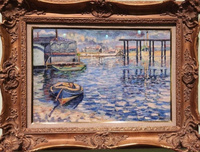
The repeated encounter with extraordinary, little-known canvases is one of the Chicago exhibition’s great pleasures and strengths. Several works by Signac, for example, done between 1882 and 1900, open one’s eyes to the breadth, variety, and unexpectedness of his approach to the complexity of the riverain banlieue in painted form. His 1882 canvas, Asnières Study (Laundry Boat) (fig. 8), is a high chroma, loosely brushed, frontal scene, dominated by saturated royal blues, which includes multiple structures coexisting in a demarcated portion of the river. The picture painstakingly describes without withholding the pleasures of bravado painterly manipulation and surface variety.
Surely one of the exhibition’s most surprising and pleasing canvases is another work by Signac, his Road to Gennevilliers from 1883 (fig. 9). A sweeping, diagonally configured open space structured by blue orthogonal tree shadows gives onto a distant landscape of small scale and subtly described factories and belching chimneys arrayed along the horizon. This spare landscape contrasts sharply with his later works often populated by pointillist workers. His 1886 canvas, Gasometers at Clichy (fig. 10), a much better-known picture, is a tour de force of the aestheticization of the intrusive metallic structures of the newly ramped-up fuel production and storage needs of urban modernity. The two round tanks, encircled by rigorously geometric networks of grey pipes, elegantly, even demurely, occupy the sides of the composition, framing the volumetric mosaic of relatively conventional buildings in between.
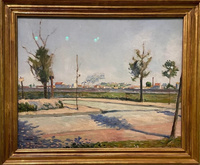
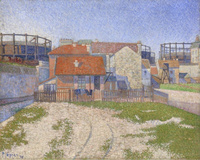
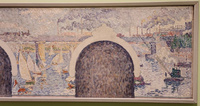
My valentine to the Signac canvases hanging in the Chicago exhibition culminates with the Sketch of the Central Panel, Design for the Decoration of the Reception Room of the Town Hall of Asnieres (1900), a portion of which appears here (fig. 11). With this sketch, visitors were treated to an example of Signac’s mature and stringent pointillist (or neo-impressionist) handling of a panorama of industry and mechanized transport combined with leisurely sailing on the river in an elegantly geometricized and balanced composition. Unlike the painterly freedom, bright color, and turgid paint surfaces found in his 1882 canvas (see fig. 8), a rigorously stylized and perfectly symmetrical composition which delivered a comprehensive assessment of the signature features of modern Asnières has been devised by the artist. His sketch was entered into a competition to paint a mural in Asnières’s town hall, a project helpfully discussed by Charlotte Helman in the exhibition catalogue (124–29).
Bernard’s canvases stand out and apart from the work of his colleagues by striking loud notes of invention, individuality, and ambition.[5] The asymmetry, close-up perspective, and minimalism of Fisherman and Boat (fig. 12), for example, are idiosyncratic in the framework of his erstwhile colleagues’ work, to say the least. The stylization of all the ingredients of Iron Bridges, Asnières (fig. 13) produces a schematic image of this much-examined place that tilts more towards abstraction than any other painting on display. But perhaps the most surprising is The Women on the Asnières Footbridge (fig. 14). Its flat planes of saturated color and simplified figures point to the approach he would adopt when he joined the circle of Gauguin in Pont-Aven not long after this painting. His handling of the two female figures returns us to a concern expressed earlier in the review. The older woman on the bridge shown in profile, overlapped by her dark-haired younger companion, is not only simplified but caricatured and de-Venustated (to use an apt term made famous long ago by Leo Steinberg).
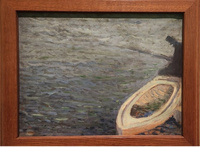
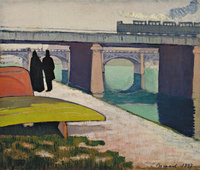
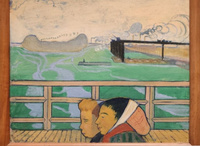
By and large, the artworks displayed in Chicago were well served by their installation. The first component of the exhibition, just at the threshold of the entry to the exhibition galleries proper on the top floor of the Rice Building, was a viewing chamber for a documentary video that helpfully presented a sequence of postcard photos of many of the places and structures painted by the five artists.[6] The installation comprised a well-illuminated and refreshingly mint green sequence of galleries. The exhibition galleries were encircled by a matte black wall enlivened by a continuous white serpentine line (representing the Seine) that bore a sequence of dates and information. The green core was bordered by a straight wall on one side (fig. 15) and a curved enclosure on the opposite side (fig. 16). Each of the individual galleries contained an amply spaced sequence of rectangular artworks joined together by a motif or theme emblazoned upon wall texts.
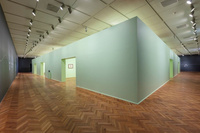
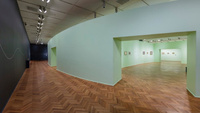
The excitement I experienced during my encounter with the artworks hanging on the walls in Chicago is evident, even though I have only been able to include a selection of them in this review. But the pleasure I took in examining the works on display was somewhat undermined by the small square window cut into a wall in almost all of the galleries (fig. 17). Each window-like opening gave onto an artwork in the adjoining space, but its visibility did not synch up with the theme being examined in the gallery otherwise. Thus, the little windows were distracting and confusing. Old timers of the Chicago art scene—especially those who have been aficionados of the nineteenth-century French art exhibited at the Art Institute over the years—will recall the much-admired 1984 exhibition, A Day in the Country, curated in Chicago by the late Richard Brettell.[7] The installation was designed by the eminent Chicago architect, John Vinci. It too featured windows cut into the wall in each of the galleries, as I recall, but the opening gave onto something—an artwork, a document, a photograph, a map—that legibly supplemented what was hung in the gallery. In the show under review here, I also had some difficulty with the surrounding black wall bearing the wavy line. Repeatedly when dates appeared they did not correlate with the gallery they adjoined. A case in point (fig. 18). It bore very pertinent information—the date of Van Gogh’s departure from Paris for Provence—but it did not correlate with what was shown in the adjacent space.
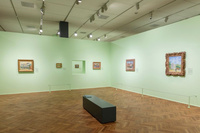
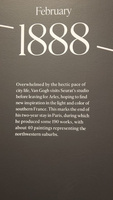
As I have strongly implied, the essays in the exhibition catalogue go a long way towards answering questions raised by the organization of and didactics appearing in the spaces of display themselves. I have already taken the opportunity to recommend certain catalogue essays, and I will conclude by doing so again: the introductory essay by the co-curators (24–27), Jacquelyn Coutré’s targeted discussion of the cultural landscape of Asnières (28–49), Bregje Gerritse’s presentation of Van Gogh’s work in Asnières (66–93), Charlotte Hellman’s discussion of Signac in Asnières (112–29), and Joost van der Hoeven on Bernard and Asnières (130–51). Each is a triumph of new research and crystal-clear analysis.[8] Last words: see the exhibition in Amsterdam and read the catalogue.
Notes
[1] Van Gogh’s standing is similar to what Malcolm Bull has recently noted about the reputation of Gerhard Richter. See Malcolm Bull, “Squeegee Abstracts,” review of Gerhard Richter: Painting after the Subject of History, by Benjamin H.D. Buchloh, London Review of Books 45, no. 16 (August 10, 2023): 5–6, 8. As I write this, the Canadian company behind the wildly popular “Immersive Van Gogh” experience, Lighthouse Immersive, has filed for bankruptcy. See Sarah Cascone, “The Company Behind the Wildly Popular ‘Immersive Van Gogh’ Experience Has Filed Bankruptcy,” Artnet News, August 1, 2023, https://news.artnet.com/.
[2] Catherine Porter and Constant Méheut, “Riots in France Highlight a Vicious Cycle Between Police and Minorities,” New York Times, July 17, 2023.
[3] Among the first-generation practitioners of the “social history of art,” the pioneers of the investigation of the treatment of the industrializing suburbs by the vanguard landscapists of the 1870s and 1880s include T. J. Clark, the late Robert Herbert, and James Rubin. Their books appear in the catalogue bibliography. Absent however from the literature cited is the catalogue of an important recent exhibition in France: Véronique Alemany, Peindre la banlieue, de Corot à Vlaminck, 1850–1950 (Painting the Banlieue from Corot to Vlaminck, 1850–1950) (Ville d’Issy-les-Moulineaux; Cergy Pointoise: Editions de Valhermeil, 2016). The exhibition covered an entire century and a much broader swath of areas surrounding Paris, but it also bore down on artwork set in the area (the Département des Hauts-de-Seine) containing the primary locations covered by the Chicago exhibition. The key section is “L’hégémonie industrielle de la banlieue (The Industrial Hegemony of the Banlieue),” 92–125.
[4] I explored Van Gogh’s technologized motif enthusiasm in Paris and Arles, and its subsequent cessation under the influence of Gauguin, years ago. Hollis Clayson, “‘Some Things Bear Fruit’? Witnessing the Bonds between Van Gogh and Gauguin: The Studio of the South,” The Art Bulletin 84, no. 4 (December 2002): 670–84. See especially 673–74, and 683n27 and 28.
[5] Joost van der Hoeven’s catalogue essay, “Bernard and Asnières” (130–51) is essential reading for tracking the twists and turns of Bernard’s early career.
[6] Also worthwhile in the same vein is “Postcards along the Seine,” by Teio Meedendorp in the exhibition catalogue, 50–65.
[7] A Day in the Country: Impressionism and the French Landscape, exh. cat. (Los Angeles: The Los Angeles County Museum of Art; Chicago: The Art Institute of Chicago; Paris: La Réunion des Musées Nationaux, 1984).
[8] I hasten to add that Richard Thomson’s essay on Seurat (94–111) is also first-rate, but I did not reference it specifically because Seurat’s art has been the most exhaustively studied and is the most familiar to me, so I did not engage the works by Seurat and Thomson’s account in my review. François Lespinasse’s fine essay, “Angrand: Expressive Harmonies from Saint-Ouen and Asnières to Courbevoie,” (152–67) opens with this observation: “Charles Angrand is one of the least well-known painters in this catalogue, largely because his output included fewer than one hundred paintings. Of these works, six were painted in the suburbs of Paris around Asnières and the Seine between 1885 and 1889 . . . ” (153). My neglect of his work in the exhibition will unfortunately perpetuate his relative obscurity.